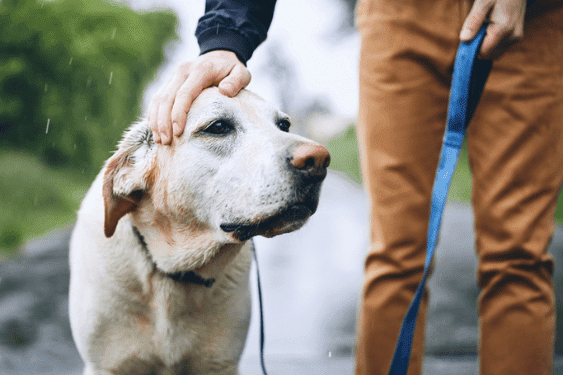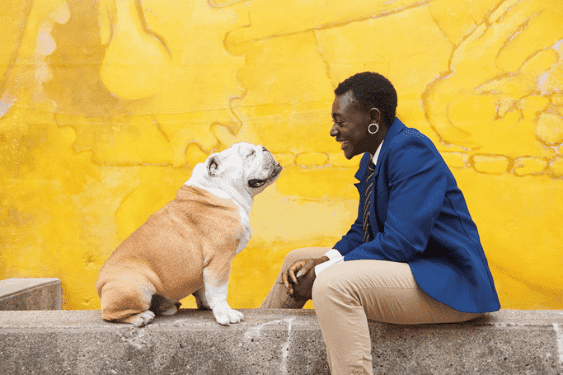Keyphrase: Greeting Dogs
Greeting Dogs Properly: 10 Tips for safe Human-canine Interactions
“The major cause of dog bites to humans is related to failure of owners and dog bite victims to recognize when dogs are fearful and know how to approach and greet dogs appropriately.”
-Dr. Sophia Yin
Animal Behaviorist, Veterinarian, Author
When greeting dogs, our first instinct may be to excitedly run up and pet them. However, ask yourself how you would feel if a stranger ran up to you and started running their fingers through your hair. You would probably smack them. A dog might similarly become startled and react defensively. When dogs are stressed, they can bite even good-intentioned humans. Unfortunately, dogs are often the ones punished when a greeting goes wrong, even if it’s the result of human negligence. In some cases, the dog may even be put down. It is important to consider the dog’s perspective before encountering canines. Read on for 10 tips that will improve your canine etiquette and promote safety when greeting dogs.
1. Observe before Approaching dogs
Dogs are non-verbal, relying on scent and body language to communicate. Unlike humans, dogs can’t verbalize when they are anxious. A dog might seem to be acting aggressively, but he could actually be reacting to an uncomfortable environment. The most important step you can take before greeting dogs is to observe their body language. Subtle signals will alert you to a dog’s emotional state. If a dog is displaying signals of stress, it is best to respect his boundaries.
This poster by outwardhound.com illustrates some common emotional body language in dogs
https://outwardhound.com/furtropolis/dogs/how-to-approach-a-dog

Calm Signals
- Wide wagging tail
- Soft eyes: squint, almond shaped, frequent blinks
- Relaxed posture
- Leans in toward you
- Open mouth
- Ears forward and relaxed
- Play bowing
Stressed Signals
- Stiff upright tail, or tail between legs
- Hard Eyes: dilated pupils, whale eyes
- Stiff rigid body posture
- Flinches away
- Compressed, tense lips
- Ears pinned back
- Licking lips
- Yawning

2. Ask the Owner for permission
Never assume that because you are a “dog person,” you have the right to approach any dog. You don’t know the dog’s story. Different dogs have different personalities and temperaments. Some may have special needs. It is always best to ask the owner’s permission before greeting dogs. If they do consent, ask them how the dog likes to be greeted and their preferred contact method.
3. Maintain a Calm Demeanor
Dogs are fascinating and loveable creatures. You may get excited when you see one coming your way. However, you must keep your emotions in check when greeting canines, so they don’t get anxious or overstimulated. Here are some dos and don’ts you should keep in mind when meeting dogs.
Do
- Move slowly
- Keep arms at sides
- Speak in a low tone of voice
- Give the dog space
- Be patient
- Holistically observe the dog
Don’t
- Loudly clap hands
- Smile with teeth showing
- Use high-pitched “baby talk”
- Run, or make quick movements
- Use animated gestures
- Hug or try to pick up dog
4. Consider a Curved approach
Approaching dogs head-on may feel threatening to them. If you observe a dog when greeting another dog, they often approach each other by “curving” their directional path. Their body also curves into a C-shape. You should do the same by avoiding a straight-on path when you are greeting dogs. Keeping your shoulders square might seem confrontational. Turn your body slightly away instead of facing them. This is considered a polite gesture in dog language.
5. Avert gaze when greeting dogs
Although direct eye contact is encouraged in human interactions, canines interpret it as rudeness. Instead, turn your head slightly away from the dog. Use your peripheral vision to look at them. Keep your eyes soft, blinking frequently and slowly. This will subtly signal that you are not a threat. The worst thing you can do is put your face right up to an unfamiliar dog’s face. This could startle them and provoke a bite.
6. Pass the Sniff test
If a dog chooses to approach you, keep your arms by your side and hands to yourself. Let the dog slowly come in for a sniff. Dogs have a keen sense of smell and can tell a lot about you from your scent. Don’t be offended if they give you a quick whiff and walk away. For some dogs, a sniff is enough. Don’t feel like you are being snubbed. In fact, the dog may like you better for respecting their space.

7. To Pet or not to Pet?

Ultimately, it is neither your choice nor the owners’ choice to pet a dog. It is the dog’s choice. If you pass the sniff test, the dog may solicit a pet by leaning in toward you. Perhaps he will gently nudge you to pet him. Opt for petting the neck, chest, or shoulders, before moving to the head. Take frequent breaks from petting as a way of asking “is this still okay with you?”

8. Don’t encourage bad behavior
Properly greeting dogs is about fostering mutual respect. If a dog gets overly pushy with you, don’t let him invade your space. Turn your body away if he starts jumping up at you and stop giving positive attention. Even if you personally don’t “mind” this behavior, it shouldn’t be encouraged. Dog owners work hard to teach their dogs good manners. Rewarding brash behavior will counteract their training and confuse the dog.
9. Teach Children how to Greet dogs politely
Because of their playfulness and naivety, children are often the worst offenders for improperly greeting dogs. Being small and low to the ground, children are at a greater risk for dog-related injuries. Unlike their stuffed animals, dogs are not toys. Canine behavior in real life is very different from the personified dog characters in cartoons. This printable coloring book by the AMVA, illustrates children’s appropriate behavior towards dogs. Dr. Sophia Yin also created this fun poster to foster canine empathy and teach children to consider their actions from a dog’s perspective. Please share it with your children.
https://bccampus.ca/wp-content/uploads/2022/02/Yin-How-to-Greet-a-Dog-Poster.pdf

10. Be an advocate for your dog
If you are a dog owner, you must put your dog and safety first. Don’t force your dog into uncomfortable situations to people please. Let your dog build up their social skills at their own pace. Your dog might not be able to speak, but you can speak up for them when you sense your dog is uncomfortable.

Building awareness about canine behavior will help change human expectations when greeting dogs. By respecting a dog’s boundaries people can prevent dog bites, and dogs can avoid unnecessary punishment. Let’s respect our furry friends.
Do you have any additional tips for greeting dogs properly? What are some of your pet peeves when people greet your dog? Comment below with your thoughts and experiences.